U.S. Capitol Visitor Guide
Your visit to the historic U.S. Capitol begins as you enter the Capitol Visitor Center. With its soaring spaces and skylight views of the Capitol Dome, the Capitol Visitor Center welcomes you on a journey of discovery. The U.S. Capitol is home to the U.S. Congress and its two legislative bodies, the U.S. House of Representatives and the U.S. Senate. Through films, exhibits and tours, you will learn about how Congress works, how this magnificent building was built, and how citizens can participate in this extraordinary experiment called representative democracy.
The U.S. Capitol stands as a monument to the American people. It is where the issues facing the nation are considered, debated and written into law. The U.S. Capitol also houses an important collection of American art, and it is an architectural achievement in its own right. History is made at the U.S. Capitol, and the Capitol Visitor Center is your entryway to that history.
On December 18, 2007, Congress passed legislation to name the Capitol Visitor Center’s central space “Emancipation Hall” to recognize the contributions of enslaved laborers who helped build the U.S. Capitol. Emancipation Hall, on the lower level of the Capitol Visitor Center, is a central gathering place for visitors coming to see the Capitol.
Guided Tours of the U.S. Capitol
 Guided tours of the U.S. Capitol begin at the Orientation Theaters on the lower level of the Capitol Visitor Center. “Out of Many, One,” a 13-minute film, illustrates how this country established a new form of government; highlights the vital role that Congress plays in the daily lives of Americans; and introduces you to the building that houses the U.S. Congress. Tours of the Capitol are free and are offered throughout the day between 8:40 a.m. – 3:20 p.m., Monday – Saturday. Tour passes are required. Advance Passes: Tours may be booked in advance online at www.visitthecapitol.gov, through the offices of your senators or representative, or by calling the Capitol Visitor Center Office of Visitor Services at 202.226.8000. Same-Day Passes: A limited number of passes are available each day at the Information Desks in Emancipation Hall on the lower level of the Capitol Visitor Center.
Guided tours of the U.S. Capitol begin at the Orientation Theaters on the lower level of the Capitol Visitor Center. “Out of Many, One,” a 13-minute film, illustrates how this country established a new form of government; highlights the vital role that Congress plays in the daily lives of Americans; and introduces you to the building that houses the U.S. Congress. Tours of the Capitol are free and are offered throughout the day between 8:40 a.m. – 3:20 p.m., Monday – Saturday. Tour passes are required. Advance Passes: Tours may be booked in advance online at www.visitthecapitol.gov, through the offices of your senators or representative, or by calling the Capitol Visitor Center Office of Visitor Services at 202.226.8000. Same-Day Passes: A limited number of passes are available each day at the Information Desks in Emancipation Hall on the lower level of the Capitol Visitor Center.
Specialty Tours and Programs
Learn more about the history of Congress and the Capitol through a specialty tour or activity. Check for updated schedules at the Information Desks in Emancipation Hall or at www. visitthecapitol.gov/event-calendar.
Exhibition Hall
Visit Exhibition Hall and experience our interactive exhibits dedicated to telling the story of Congress and the U.S. Capitol. Try your hand at passing legislation. Explore the many beautiful rooms of the Capitol on a virtual tour. Learn how citizens interacted with Members of Congress in the development of 12 major pieces of legislation. Get a real feel for the Capitol through our touchable models and objects. Participate in hands-on learning activities in the Democracy Lab. 8:30 a.m. – 4:30 p.m., Monday – Saturday. Enter behind the Statue of Freedom on the lower level of the Capitol Visitor Center.
Watching Congress In Session
Passes: The Senate and House Galleries are open to visitors whenever either body is in session; however, the Galleries are not included in the tour of the U.S. Capitol. Passes are required and may be obtained from the offices of your senators or representative. Access to the Galleries begins on the upper level of the Capitol Visitor Center. International visitors may inquire at the House and Senate Appointment Desks on the upper level. House Hours: When the House is not in session, visitors with passes are admitted to the Gallery from 9 a.m. – 4 p.m., Monday – Friday. Last entry into the Gallery may be prior to 4 p.m. based on demand. The Gallery is closed on weekends and holidays unless the House is in session. The House Gallery is subject to unplanned, temporary closures when the House is not in session. For additional information on the House of Representatives please visit www.house.gov. Senate Hours: The Senate Gallery is open during scheduled recesses of one week or more, and visitors with passes are admitted from 9 a.m. – 4:15 p.m., Monday – Friday. The Gallery is closed on weekends and holidays unless the Senate is in session and during any recess or adjournment of less than one week. Senate Gallery hours are subject to change. For information please call 202.224.0057.
Library of Congress
Visitors have direct access from the Capitol Visitor Center to the historic Thomas Jefferson Building of the Library of Congress, one of the nation’s great treasures, via the Library of Congress Tunnel. The entrance to the tunnel is located on the upper level of the Capitol Visitor Center near the House Appointment Desk.
The Capitol Grounds
 The Capitol is set amidst 58.8 acres of winding paths, memorial trees, inviting benches and beautiful flowers that are changed seasonally. The grounds today reflect a plan completed in 1892 by renowned landscape architect Frederick Law Olmsted. As you stroll the grounds, note the magnificent bronze and stone fountains and lanterns on the East Plaza, which were restored to their original beauty during construction of the Capitol Visitor Center. The Capitol Grounds have played host to presidential inaugurations, Independence Day concerts, and the yearly visits of more than three million people. We invite you to enjoy this historic landscape.
The Capitol is set amidst 58.8 acres of winding paths, memorial trees, inviting benches and beautiful flowers that are changed seasonally. The grounds today reflect a plan completed in 1892 by renowned landscape architect Frederick Law Olmsted. As you stroll the grounds, note the magnificent bronze and stone fountains and lanterns on the East Plaza, which were restored to their original beauty during construction of the Capitol Visitor Center. The Capitol Grounds have played host to presidential inaugurations, Independence Day concerts, and the yearly visits of more than three million people. We invite you to enjoy this historic landscape.
Must See on Your Visit
Specialty Tours — ask a Capitol Visitor Center staff or view the Calendar page for schedules
Special Activities and Family Programs — view the Calendar page or ask Capitol Visitor Center staff for schedules
Table from President Abraham Lincoln’s Second Inauguration — made from surplus ironwork cast for the Capitol Dome (Exhibition Hall, courtesy The Massachusetts Historical Society)
View of Dome through Skylights — from the lower or upper level of the Visitor Center, just look up!
The Plaster Model for the Statue of Freedom — used to cast the bronze Statue of Freedom atop the Capitol Dome (Emancipation Hall)
Statue Collection —Some of the statues of the National Statuary Hall Collection are located throughout the Capitol Visitor Center, including 14 statues in Emancipation Hall (Please see reverse side for statue descriptions.)
House and Senate Galleries — entry on upper level of Visitor Center – get passes from your Senators or Representative
Slave Labor Commemorative Marker — sandstone marker recognizing the role that enslaved laborers played in the construction of the Capitol (Emancipation Hall)
U.S. Capitol Visitor Center
| 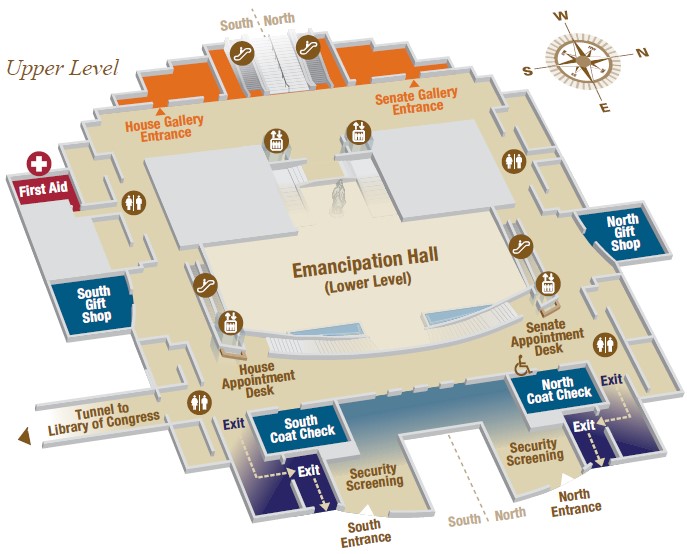 |
Gift ShopsGift Shops (Upper Level): Check out our unique selection of merchandise inspired by the Capitol’s art and architectural treasures, fun and educational gifts, books, jewelry and items only found at the Capitol Visitor Center. All items proudly made in the USA. 9 a.m. – 4:30 p.m., Monday – Saturday. DiningCapitol Cafe (Lower Level): Freshly-made soups, salads, specialty entrées, pizzas, sandwiches, desserts, and beverages reflect the diverse bounty of America. 8:30 a.m. – 4 p.m., Monday – Saturday | 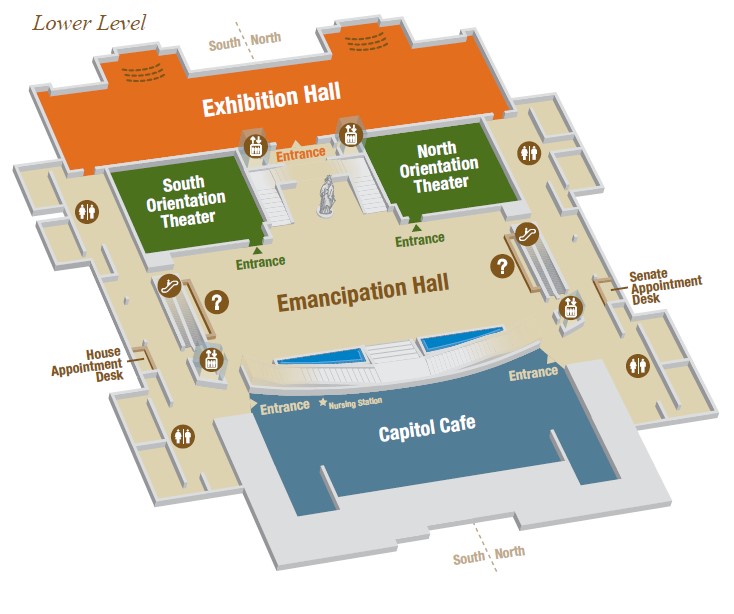 |
Statues in the Capitol Visitor Center
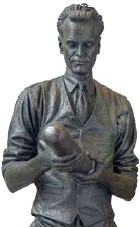
Philo T. Farnsworth (1906–1971) Utah, Bronze by James R. Avati, 1990. Inventor. Called “the father of television” for devising an early electronic television system, which he first conceived in high school. Early televisions used 100 of his patents. Received more than 160 patents for inventions used in the development of the infrared night light, electron microscope, baby incubator, gastroscope, astronomical telescope, and radar. Shown holding an electronic camera tube that he invented in the 1920s.
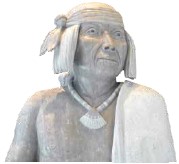 Po’pay (1630?–before 1692) New Mexico, Marble by Cliff Fragua, 2005. Pueblo religious and spiritual leader. Born in San Juan Pueblo, now New Mexico. Organizer of the Pueblo Revolt against the Spanish in 1680, which helped ensure the survival of the Pueblo culture and shaped the history of the American Southwest. Holds a bear fetish and the knotted rope used to coordinate the timing of the uprising; the sculpture includes a pot, a symbol of Pueblo culture.
Po’pay (1630?–before 1692) New Mexico, Marble by Cliff Fragua, 2005. Pueblo religious and spiritual leader. Born in San Juan Pueblo, now New Mexico. Organizer of the Pueblo Revolt against the Spanish in 1680, which helped ensure the survival of the Pueblo culture and shaped the history of the American Southwest. Holds a bear fetish and the knotted rope used to coordinate the timing of the uprising; the sculpture includes a pot, a symbol of Pueblo culture.
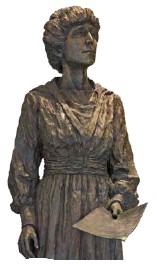 Jeannette Rankin (1880–1973) Montana, Bronze by Terry Minmaugh, 1985. Social worker, lecturer, and U.S. Representative who served from 1917–1919 and from 1941–1943. First woman elected to Congress. Noted lobbyist for peace and women’s rights. Voted against America’s entry into World Wars I and II. Only Member of Congress to oppose declaration of war on Japan in 1941, saying, “As a woman I can’t go to war...and I refuse to send anyone else.”
Jeannette Rankin (1880–1973) Montana, Bronze by Terry Minmaugh, 1985. Social worker, lecturer, and U.S. Representative who served from 1917–1919 and from 1941–1943. First woman elected to Congress. Noted lobbyist for peace and women’s rights. Voted against America’s entry into World Wars I and II. Only Member of Congress to oppose declaration of war on Japan in 1941, saying, “As a woman I can’t go to war...and I refuse to send anyone else.”
 Maria L. Sanford (1836–1920) Minnesota, Bronze by Evelyn Raymond, 1958. Educator and champion of women’s rights. Supported suffrage for women and the education of African Americans; pioneered the concept of adult education and parent-teacher organizations. Graduated from Connecticut Normal School. Professor of history at Swarthmore College. Taught for 20 years at University of Minnesota. One of the first women to become a college professor.
Maria L. Sanford (1836–1920) Minnesota, Bronze by Evelyn Raymond, 1958. Educator and champion of women’s rights. Supported suffrage for women and the education of African Americans; pioneered the concept of adult education and parent-teacher organizations. Graduated from Connecticut Normal School. Professor of history at Swarthmore College. Taught for 20 years at University of Minnesota. One of the first women to become a college professor.
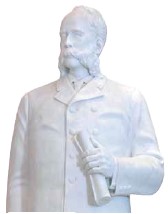 Joseph Ward (1838–1889) South Dakota, Marble by Bruno Beghé, 1963. Missionary and educator. Leader in movement for South Dakota statehood. Ordained in Yankton, capital of Dakota Territory. Opened Yankton Academy and was instrumental in founding Yankton College. Drafted state constitution, and composed state motto and description for the state seal.
Joseph Ward (1838–1889) South Dakota, Marble by Bruno Beghé, 1963. Missionary and educator. Leader in movement for South Dakota statehood. Ordained in Yankton, capital of Dakota Territory. Opened Yankton Academy and was instrumental in founding Yankton College. Drafted state constitution, and composed state motto and description for the state seal.
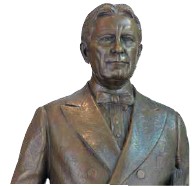 William Edgar Borah (1865 –1940) Idaho, Bronze by Bryant Baker, 1947. Lawyer, U.S. Senator 1907–1940. As Chairman of the Committee on Education and Labor, sponsored bills that created the Department of Labor and the Children’s Bureau. Chairman of the Senate Committee on Foreign Relations. Outstanding orator, known as the “Lion of Idaho.”
William Edgar Borah (1865 –1940) Idaho, Bronze by Bryant Baker, 1947. Lawyer, U.S. Senator 1907–1940. As Chairman of the Committee on Education and Labor, sponsored bills that created the Department of Labor and the Children’s Bureau. Chairman of the Senate Committee on Foreign Relations. Outstanding orator, known as the “Lion of Idaho.”
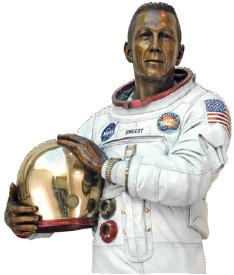 John L. “Jack” Swigert, Jr. (1931–1982) Colorado, Bronze by George and Mark Lundeen, 1997. Pilot and astronaut. Air Force combat pilot in Korea and test pilot. One of three crew members aboard 1970 National Aeronautics and Space Administration (NASA) Apollo 13 moon mission, aborted after an oxygen tank ruptured. Crew spent almost six days in space. Executive director of House Committee on Science and Technology. Elected to the House of Representatives in 1982, but died one week before taking office.
John L. “Jack” Swigert, Jr. (1931–1982) Colorado, Bronze by George and Mark Lundeen, 1997. Pilot and astronaut. Air Force combat pilot in Korea and test pilot. One of three crew members aboard 1970 National Aeronautics and Space Administration (NASA) Apollo 13 moon mission, aborted after an oxygen tank ruptured. Crew spent almost six days in space. Executive director of House Committee on Science and Technology. Elected to the House of Representatives in 1982, but died one week before taking office.
 Chief Washakie (1800?–1900) Wyoming, Bronze by Dave McGary, 2000. Warrior and spokesman for Shoshone tribe. Fluent in French, English, and several Native American languages. He united several Shoshone bands. Negotiated with the U.S. Army to ensure preservation of more than three million acres in Wyoming as home to the Shoshone. Given a full U.S. military funeral. Details of clothing are finely painted in color.
Chief Washakie (1800?–1900) Wyoming, Bronze by Dave McGary, 2000. Warrior and spokesman for Shoshone tribe. Fluent in French, English, and several Native American languages. He united several Shoshone bands. Negotiated with the U.S. Army to ensure preservation of more than three million acres in Wyoming as home to the Shoshone. Given a full U.S. military funeral. Details of clothing are finely painted in color.
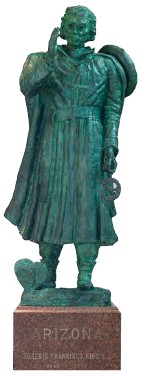 Eusebio Francisco Kino (1645–1711) Arizona, Bronze by Suzanne Silvercruys, 1965. Missionary, explorer, and cartographer. Jesuit priest born in Italy. Led exploratory expeditions to Mexico and lower California and worked with Pima Indians in southern Arizona. Built missions, ranches, and roads in California and Arizona. Shown holding an astrolabe, used in calculating latitude from the stars.
Eusebio Francisco Kino (1645–1711) Arizona, Bronze by Suzanne Silvercruys, 1965. Missionary, explorer, and cartographer. Jesuit priest born in Italy. Led exploratory expeditions to Mexico and lower California and worked with Pima Indians in southern Arizona. Built missions, ranches, and roads in California and Arizona. Shown holding an astrolabe, used in calculating latitude from the stars.
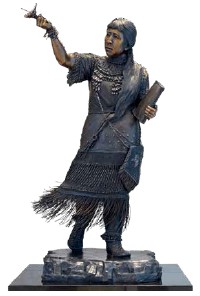 Sarah Winnemucca (1844–1891) Nevada, Bronze by Benjamin Victor, 2005. Interpreter, educator, and author. Negotiated between her Paiute people and the U.S. Army. Started a school for Native American children, teaching in both the native language and English. Her autobiography, “Life Among the Piutes: Their Wrongs and Claims,” was the first book written by a Native American woman. Holds a shellflower, her name in the Paiute language.
Sarah Winnemucca (1844–1891) Nevada, Bronze by Benjamin Victor, 2005. Interpreter, educator, and author. Negotiated between her Paiute people and the U.S. Army. Started a school for Native American children, teaching in both the native language and English. Her autobiography, “Life Among the Piutes: Their Wrongs and Claims,” was the first book written by a Native American woman. Holds a shellflower, her name in the Paiute language.
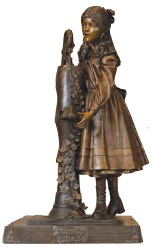 Helen Keller (1880–1968) Alabama, Bronze by Edward Hlavka, 2009. Author, lecturer and activist for persons with disabilities and for other social causes. Became blind and deaf following an illness in infancy. Learned sign language, speech, and Braille. First blind and deaf person to graduate from college. Known as “America’s goodwill ambassador to the world.” Shown as a seven-year-old child at the water pump at her home in Tuscumbia, Alabama, where she first understood the word “water” and learned to communicate.
Helen Keller (1880–1968) Alabama, Bronze by Edward Hlavka, 2009. Author, lecturer and activist for persons with disabilities and for other social causes. Became blind and deaf following an illness in infancy. Learned sign language, speech, and Braille. First blind and deaf person to graduate from college. Known as “America’s goodwill ambassador to the world.” Shown as a seven-year-old child at the water pump at her home in Tuscumbia, Alabama, where she first understood the word “water” and learned to communicate.
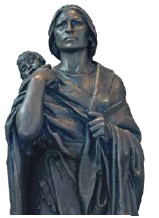 Sakakawea (1788?–1812) North Dakota, Bronze, replica of 1910 statue by Leonard Crunelle, 2003. Interpreter and guide. In 1805, carrying her newborn son, assisted Northwest Expedition headed by Meriwether Lewis and William Clark in what is today North Dakota. Her presence was a sign to tribes that the expedition was peaceful. Honored as traveler, translator, diplomat, wife, and mother. Named Sakakawea, or “Bird Woman,” by her Hidatsa tribe.
Sakakawea (1788?–1812) North Dakota, Bronze, replica of 1910 statue by Leonard Crunelle, 2003. Interpreter and guide. In 1805, carrying her newborn son, assisted Northwest Expedition headed by Meriwether Lewis and William Clark in what is today North Dakota. Her presence was a sign to tribes that the expedition was peaceful. Honored as traveler, translator, diplomat, wife, and mother. Named Sakakawea, or “Bird Woman,” by her Hidatsa tribe.
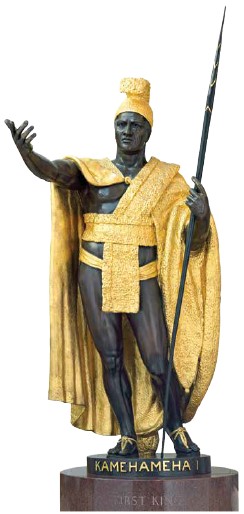
King Kamehameha I (1758?–1819) Hawaii, Bronze and gold, replica of 1879 statue by Thomas R. Gould, 1969. Warrior and king. Unified all the inhabited islands of Hawaii under his rule. Encouraged trade and opened Hawaii to the rest of the world. Also called Kamehameha the Great. Shown wearing the gilded regalia of Hawaiian royalty including a helmet and a cloak of Hawaii Mamo bird feathers.
 Mother Joseph (1823–1902) Washington, Bronze by Felix W. de Weldon, 1980. Missionary and architect. Born Esther Pariseau near Montreal, Canada. Became a Catholic nun at age 20. Led missionaries to the U.S. Pacific Northwest Territories, including the future state of Washington. Designed, oversaw construction, and raised funds for 11 hospitals, seven academies, five Native American schools, and two orphanages. Shown on the pedestal are drafting instruments and images of some of her buildings.
Mother Joseph (1823–1902) Washington, Bronze by Felix W. de Weldon, 1980. Missionary and architect. Born Esther Pariseau near Montreal, Canada. Became a Catholic nun at age 20. Led missionaries to the U.S. Pacific Northwest Territories, including the future state of Washington. Designed, oversaw construction, and raised funds for 11 hospitals, seven academies, five Native American schools, and two orphanages. Shown on the pedestal are drafting instruments and images of some of her buildings.
The Statue of Freedom
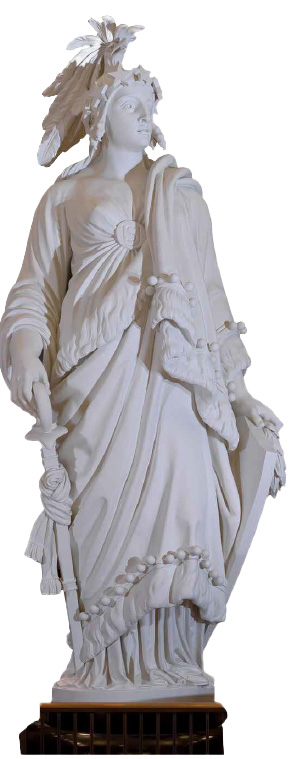 The original plaster model for the bronze Statue of Freedom atop the Capitol Dome has been restored and is now the focal point of Emancipation Hall in the Capitol Visitor Center, giving visitors an up-close view of the allegorical figure. The model is 19½ feet tall and weighs approximately 13,000 pounds.
The original plaster model for the bronze Statue of Freedom atop the Capitol Dome has been restored and is now the focal point of Emancipation Hall in the Capitol Visitor Center, giving visitors an up-close view of the allegorical figure. The model is 19½ feet tall and weighs approximately 13,000 pounds.
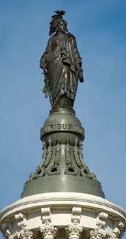 In 1857, Thomas Crawford, an American sculptor working in Rome, completed the plaster model for the Statue of Freedom. After Crawford’s death, another American sculptor, Clark Mills, was hired to cast the statue at his foundry in the District of Columbia. When the worker who had put the plaster model together refused to disassemble it unless his unreasonable demands for extra pay were met, Philip Reid, an enslaved craftsman owned by Clark Mills, determined how to separate the sections so they could be moved to the foundry for casting.
In 1857, Thomas Crawford, an American sculptor working in Rome, completed the plaster model for the Statue of Freedom. After Crawford’s death, another American sculptor, Clark Mills, was hired to cast the statue at his foundry in the District of Columbia. When the worker who had put the plaster model together refused to disassemble it unless his unreasonable demands for extra pay were met, Philip Reid, an enslaved craftsman owned by Clark Mills, determined how to separate the sections so they could be moved to the foundry for casting.
At the foundry, Reid was put in charge of keeping the fire going under the molds, and he worked with other enslaved laborers as the sections of the plaster model were cast into bronze. Philip Reid was emancipated shortly before the completed bronze statue was moved to the Capitol Grounds in 1862, and he was a free man when the last piece was put in place on the Dome on December 2, 1863.
The plaster model for the Statue of Freedom stands prominently at the west side of Emancipation Hall in front of the entrance to Exhibition Hall.
Statues on the Upper Level of the Capitol Visitor Center
The following three statues are located on the Upper Level East Lobby overlooking Emancipation Hall.
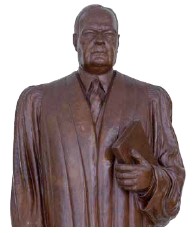 Edward Douglass White (1845–1921) Louisiana, Bronze by Arthur C. Morgan, 1955. Lawyer, state legislator, U.S. Senator 1891–1894, U.S. Supreme Court justice 1894–1921, and served as Chief Justice of the United States 1910–1921. Enlisted in the Confederate Army at age 16, but later as Supreme Court justice supported the right of African Americans to vote. Appointed to Supreme Court by President Cleveland.
Edward Douglass White (1845–1921) Louisiana, Bronze by Arthur C. Morgan, 1955. Lawyer, state legislator, U.S. Senator 1891–1894, U.S. Supreme Court justice 1894–1921, and served as Chief Justice of the United States 1910–1921. Enlisted in the Confederate Army at age 16, but later as Supreme Court justice supported the right of African Americans to vote. Appointed to Supreme Court by President Cleveland.
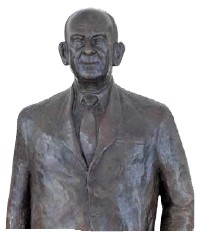 Ernest Gruening (1886–1974) Alaska, Bronze by George Anthonisen, 1977. Journalist, Governor of the Territory of Alaska, and U.S. Senator 1959–1969. Graduated from medical school, but became a reporter, editor, and managing editor in Boston and New York. Appointed to Alaska International Highway Commission. Served as governor from 1939 until retirement in 1953. One of first two senators from Alaska. Called “the father of Alaska Statehood.”
Ernest Gruening (1886–1974) Alaska, Bronze by George Anthonisen, 1977. Journalist, Governor of the Territory of Alaska, and U.S. Senator 1959–1969. Graduated from medical school, but became a reporter, editor, and managing editor in Boston and New York. Appointed to Alaska International Highway Commission. Served as governor from 1939 until retirement in 1953. One of first two senators from Alaska. Called “the father of Alaska Statehood.”
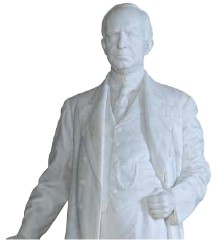 James P. Clarke (1854–1916) Arkansas, Marble by Pompeo Coppini, 1921. Lawyer, state legislator and attorney general, governor, and U.S. Senator 1903–1916. Twice elected President pro tempore of the Senate. Supported the Panama Canal project and Philippine independence. As Chairman of the Senate Commerce Committee, helped pass employers’ liability and workmen’s compensation legislation.
James P. Clarke (1854–1916) Arkansas, Marble by Pompeo Coppini, 1921. Lawyer, state legislator and attorney general, governor, and U.S. Senator 1903–1916. Twice elected President pro tempore of the Senate. Supported the Panama Canal project and Philippine independence. As Chairman of the Senate Commerce Committee, helped pass employers’ liability and workmen’s compensation legislation.
Honoring Human Rights Leaders
Frederick Douglass, (1818–1895) was born into slavery in Talbot County, Maryland. He became one of the country’s most influential advocates for civil and human rights. After escaping slavery in 1838, he moved to New Bedford, Massachusetts, and became involved in the abolition movement. He wrote three autobiographies, and in Rochester, New York, where he lived for 25 years, he published the country’s leading African American newspaper. During the Civil War Douglass recruited soldiers for the new African American regiments. He moved to Washington, D.C., in 1872, where he was several times appointed to public office, and died there in 1895. Douglass worked tirelessly throughout his life for voting rights for African Americans and women, equal rights for freedmen, and anti-lynching laws. By an act of Congress, a statue of Frederick Douglass created by Steven Weitzman and donated by the District of Columbia, was placed in Emancipation Hall June 19, 2013.
Born into slavery as Isabella Baumfree in 1797, Sojourner Truth was first sold at auction at about age nine. By the age of 30, She had been enslaved by five owners, but in 1826 she courageously walked away to be free. Inspired by her religious beliefs, Honoring Human Rights Leaders Learn more about some of the statues in Emancipation Hall and the people they represent by downloading our free “Who Are the People?” augmented reality app. Available via the Apple App Store and Google Play. Isabella changed her name to Sojourner Truth and began preaching about abolition and women’s rights. Sojourner Truth’s bust by Artis Lane is the first sculpture to honor an African American woman in the U.S. Capitol. It was unveiled in Emancipation Hall in April 2009.
Raoul Wallenberg was a Swedish diplomat who, through his country’s legation in Budapest during World War II, helped save the lives of tens of thousands of Jews threatened by the occupying Nazi forces and their Hungarian collaborators. The bust of Wallenberg by Miri Margolin was accepted by Congress in 1995.
Capitol Tour Reservations and Passes
Upon arrival at the Capitol Visitor Center, if you have made a reservation for a tour and have your reservation confirmation or confirmation number with you, please proceed to the Information Desk on the right (north) side of the lower level to receive a Capitol Tour Pass.
Please Note: The U.S. Capitol is subject to the unscheduled suspension of tours. Notices will appear on www.visitthecapitol.gov and on social media.
International Follow-along Capitol Tour Handouts with highlights of the tour are available for visitors in languages other than English at the Information Desks on the lower level of the Visitor Center and from Visitor Guides. Languages available are: Amharic, Arabic, Chinese, French, German, Hindi, Italian, Japanese, Korean, Portuguese, Russian, Spanish, and Vietnamese.
Subscribe to regular updates from the Capitol Visitor Center at www.visitthecapitol.gov/subscribe
Thank you for visiting the U.S. Capitol. Your feedback is important to us. Share your experience at comments@visitthecapitol.gov
